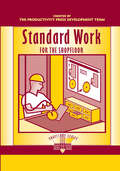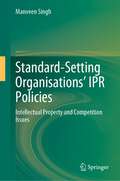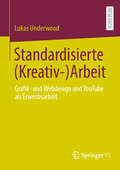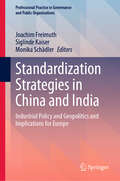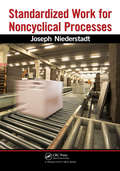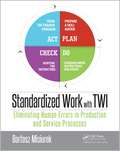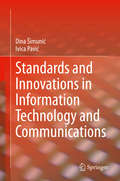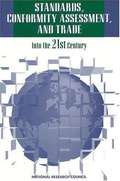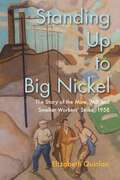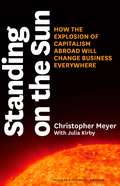- Table View
- List View
Standard Work for Lean Healthcare (Lean Tools for Healthcare Series)
by Thomas L. JacksonProven to increase efficiencies in the manufacturing sector, Standard Work has become a key element in reducing process waste, ensuring patient safety, and improving healthcare services. Part of the Lean Tools for Healthcare Series, this reader-friendly book builds on the success of the bestselling, Standard Work for the Shopfloor.Standard Work for
Standard Work for the Shopfloor (ISSN)
by 0 Productivity Press Development Team,Standard work is an agreed upon set of work procedures that effectively combines people, materials, and machines to maintain quality, efficiency, safety, and predictability. Work is described precisely in terms of cycle time, work in process, sequence, time, layout, and the inventory needed to conduct the activity. Standard work begins as an improvement baseline and evolves into a reliable method. It establishes the best activities and sequence steps to maximize performance and minimize waste.In this book you will learn about: The characteristics of standardsKey benefits and applications of standardizationStandard work concepts and calculationsStandard work steps and documentationUsing standard work manuals, charts, and worksheetsCell staffing (line balancing and full work)Productivity's Shopfloor Series books offer a simple, cost-effective approach for building basic knowledge about key manufacturing improvement topics. Like all our Shopfloor Series books, Standard Work for the Shopfloor includes innovative instructional features that are the signature of the Shopfloor Series. The goal: to place powerful and proven improvement tools such as pull production techniques in the hands of your entire workforce.
Standard of Living: Essays on Economics, History, and Religion in Honor of John E. Murray (Studies in Economic History)
by Joshua Hall Patrick Gray Ruth Wallis Herndon Javier SilvestreThis anthology honors the life and work of American economist John E. Murray, whose work on the evolution of the standard of living spanned multiple disciplines. Publishing extensively in the areas of the history of healthcare and health insurance, labor markets, religion, and family-related issues from education to orphanages, fertility, and marriage, Murray was much more than an economic historian and his influence can be felt across the wider scholarly community. Written by Murray’s academic collaborators, mentors, and mentees, this collection of essays covers topics such as the effect of the 1918 influenza pandemic on U.S. life insurance holdings, the relationship between rapid economic growth and type 2 diabetes, and the economics of the early church. This volume will be of use to scholars and students interested in economic history, cliometrics, labor economics, and American and European history, as well as the history of religion.
Standard-Setting Organisations’ IPR Policies: Intellectual Property and Competition Issues
by Manveen SinghThis book offers a unique insight into the world of standard-setting organizations (SSOs)’ IPR policies and the role they play in balancing the interests of innovators and implementers, vis-à-vis the development of standards. Since the beginning of the 21st century, there have been quite a few questions asked of the SSOs as to the legality of their IPR policies and the enforceability of disclosure and licensing obligations enshrined therein. That, coupled with disagreements over the appropriate royalty rate and royalty base, has resulted in extensive litigation between innovators and implementers, especially across the Atlantic. The Book, in keeping the USA and EU as the two primary jurisdictions, offers a comprehensive analysis of the disclosure and licensing obligations under SSO IPR policies, with strong theoretical foundations justifying their imposition. More specifically, it offers a bird’s eye view of the various facets of disclosure and licensing, ranging from non-disclosure and transparency on one hand, to the determination of FRAND on the other. While much has been said about the benefits arising out of collaborative standard-setting, disputes involving SEP licensing have not been limited to the courts, and have attracted a significant amount of scrutiny by competition/antitrust agencies. The Book provides an elaborate account of the anti-competitive concerns surrounding standard-setting, and further documents the role of courts and competition agencies in ensuring good faith licensing negotiations between the SEP holders and implementers. Despite largely focusing on SEP licensing disputes in the USA and EU, the Book also offers a dedicated chapter on standard-setting in the Indian context. The readers are presented with an in-depth discussion on the contrasting approaches adopted by the courts and the Competition Commission of India (CCI), in addressing disputes involving SEPs. The said discussion is supplemented by a careful analysis of the SEP licensing guidelines to have emerged out of other implementer-oriented economies like China and Japan. By doing so, the Book offers readers the opportunity to study and compare the SEP licensing framework in developed, as well as developing economies. SSO IPR policies play an integral role in the development of standards, and with technologies such as the Internet of Things and 5G knocking on the doors, the Book makes for a valuable study on the nuances of standard-setting through the lens of SSOs, and will find takers among a wide reader base of students, researchers, academics, law practitioners, corporates, and policy makers.
Standardisierte (Kreativ-)Arbeit: Grafik- und Webdesign und YouTube als Erwerbsarbeit
by Lukas UnderwoodFolgt man den Diagnosen verschiedener Soziolog:innen, dann ist kreativ zu sein keine Anforderung mehr an nur einige wenige Arbeitnehmer:innen, sondern bildet das zentrale Dispositiv der modernen kapitalistischen Gesellschaft. Kreativ zu arbeiten setzt den gängigen Annahmen nach voraus, erstens kontinuierlich Neues hervorzubringen und zweitens einer nicht standardisierten Tätigkeit nachzugehen und nicht standardisierte Produkte hervorzubringen. Prädestiniert für solche Tätigkeiten scheinen Solo-Selbstständige aus der Kultur- und Kreativwirtschaft zu sein. Die vorliegende Arbeit geht der Frage nach, welche Rolle Kreativität für die Arbeit von ebendiesen spielt. Hierzu wird das Verhältnis von Kreativität und Standardisierung einer genaueren Betrachtung unterzogen, wobei der Fokus auf der Ebene des Arbeitsprozesses, des Produkts sowie der Handlung liegt. Empirische Grundlage bilden 18 qualitative Interviews mit Solo-Selbstständigen aus den Bereichen Grafik- und Webdesign sowie YouTube. Die Analyse rückt die Perspektive der Befragten in den Mittelpunkt und arbeitet zunächst die jeweiligen Besonderheiten der Arbeit in den beiden genannten Bereichen heraus. Die Ergebnisse der empirischen Analyse werden zur Reflexion über die drei genannten Ebenen genutzt und das Verhältnis von Standardisierung und Kreativität als dialektisch bestimmt. Diese Dialektik zeigt sich gegenstandsbezogen und ist zutiefst verwurzelt in den spezifischen Bedingungen, unter denen die Arbeit ausgeführt wird.
Standardization Strategies in China and India: Industrial Policy and Geopolitics and Implications for Europe (Professional Practice in Governance and Public Organizations)
by Joachim Freimuth Monika Schädler Siglinde KaiserIn today's digital era, the significance of standards in modernization and innovation cannot be overstated. Often overlooked as purely technical aspects, they today reveal their profound economic and political impact. Focusing on India and China, this book sheds light onto the standardization approaches of these two dynamic nations. With insights from both academic and practical perspectives, this book shows how China's centralized planning and structured institutions contrast with India's emerging hybrid model, which reflects its rich diversity. Both countries possess untapped technological potential that is poised to reshape the global standardization landscape. What do these developments mean for the German and European economies? Find out in the concluding chapters as the authors explore the implications of these standardization trends on a global scale. This book is essential reading for professionals navigating the ever-evolving intersection of modernization, innovation, and global standards, as well as for researchers interested in a better understanding of standardization strategies.
Standardization and Innovation: Managing and Investing in IT Infrastructure
by Robert D. Austin Richard L. Nolan Shannon O'Donnell"The Adventures of an IT Leader" invites readers to "walk in the shoes" of Jim Barton, the new CIO of the fictional IVK Corporation,, as he spends a difficult year learning effective information technology leadership, sidestepping the pitfalls that make the CIO job the most volatile, high-turnover job in the business. In this chapter, Barton addresses issues around standardization and reducing infrastructure complexity. His team proposes three different approaches to achieving a balance between maintaining existing systems and investing in new functionality and ensuring standards compliance. This chapter is excerpted from "The Adventures of an IT Leader."
Standardized Work for Noncyclical Processes
by Joseph NiederstadtWhile it is a given that most Lean companies adopt methods to standardize cyclical activities, they often fail to apply the same rigor to noncyclical work, believing that it cannot be measured. Standardized Work for Noncyclical Processes cuts to the core of this mistaken belief and shows you how to measure nonrepeating job processes and eliminate waste associated with noncyclical activities. Taking a hands-on approach reflective of his time as an operator on the line, Joseph Niederstadt lays out the methods he has instituted successfully in more than 30 factories around the world. He defines and details a proven process for building consistent quality products at reduced costs, and includes coverage of activities involving multiple machine job setters, maintenance, stockers, and quality auditors. When implemented correctly this method can help you increase utilization to 85 percent through intelligent data collection.Presenting a wealth of process charts and visual reference tools, the book illustrates how to: Identify abnormalities and waste Foster teamwork and knowledge sharing Promote a safe work environment Ensure a balanced workload Establish a baseline for continuous improvements Throughout the text, the author references blank forms and offers numerous examples of what the forms should look like when populated with the proper data. The downloadable resources include e-versions of all the forms, as well as color versions of images found in the text. "Where there is no standard, there is no improvement."—Taichi Ohno, Toyota
Standardized Work with TWI: Eliminating Human Errors in Production and Service Processes
by Bartosz MisiurekThis book presents what the training within industry (TWI) program is and how its presence affects the understanding of work standardization, focusing on the practical aspects of the implementation of work standardization in the elimination of human errors in manufacturing and service processes.
Standards and Innovations in Information Technology and Communications
by Dina Šimunić Ivica PavićThis book gives a thorough explanation of standardization, its processes, its life cycle, and its related organization on a national, regional and global level. The book provides readers with an insight in the interaction cycle between standardization organizations, government, industry, and consumers. The readers can gain a clear insight to standardization and innovation process, standards, and innovations life-cycle and the related organizations with all presented material in the field of information and communications technologies. The book introduces the reader to understand perpetual play of standards and innovation cycle, as the basis for the modern world.
Standards for Enterprise Management Control
by Xianzhi ZhangThis book is mainly about facilitating the dissemination of management control, a field now finding application at a growing number of organizations, among commercial practitioners. It provides essential insights on management control as applied to Chinese enterprises and cross-border organizations. The book is divided into four parts. Part 1 provides the necessary background and framework for a discussion on enterprise management control standards, while Part 2 introduces a basic standard for enterprise management control. Part 3 introduces application guidelines for enterprise management control standards, and lastly Part 4 presents several case studies on the application of enterprise management control standards.
Standards for Management Systems: A Comprehensive Guide to Content, Implementation Tools, and Certification Schemes (Management for Professionals)
by Herfried KohlThis book guides readers through the broad field of generic and industry-specific management system standards, as well as through the arsenal of tools that are needed to effectively implement them. It covers a wide spectrum, from the classic standard ISO 9001 for quality management to standards for environmental safety, information security, energy efficiency, business continuity, laboratory management, etc. A dedicated chapter addresses international management standards for compliance, anti-bribery and social responsibility management. In turn, a major portion of the book focuses on relevant tools that students and practitioners need to be familiar with: 8D reports, acceptance sampling, failure tree analysis, FMEA, control charts, correlation analysis, designing experiments, estimating parameters and confidence intervals, event tree analysis, HAZOP, Ishikawa diagrams, Monte Carlo simulation, regression analysis, reliability theory, data sampling and surveys, testing hypotheses, and much more. An overview of the necessary mathematical concepts is also provided to help readers understand the technicalities of the tools discussed. A down-to-earth yet thorough approach is employed throughout the book to help practitioners and management students alike easily grasp the various topics.
Standards für alle: Eine Einführung in die (technische) Standardisierung
by Werner FellnerDieses Buch soll ein Bewusstsein wecken hinsichtlich der Notwendigkeit und Vorteile von innerbetrieblichen (technischen) Standards: Jedes Unternehmen hat das Ziel, effizient, innovativ und wirtschaftlich zu produzieren. Für eine effiziente Organisation und Erfüllung von zu berücksichtigenden Anforderungen können Standards maßgeblich zum Erfolg eines Unternehmens beitragen. Zu Beginn des Buches werden zu berücksichtigende Randbedingungen und Argumente für innerbetriebliche (technische) Standards aufgezeigt. Es folgen mögliche Einteilungskriterien, Definition und Grundlagen von Standards sowie deren Gestaltung und praktischen Anwendung. Im Anschluss wird das generelle Management und die Rollen im Standardisierungsprozesses beschrieben. Für eine konkrete Umsetzung in Unternehmen werden abschließend beispielhaft die grundlegenden und notwendigen Festlegungen der Standardisierung vorgestellt. Unterstützt durch viele Grafiken hilft dieses Buch beim Aufbau einer Standardisierung bzw. bei der Analyse bestehender innerbetrieblicher Standards und verschafft überraschende Einblicke in die Welt der Normen.
Standards of Value
by Jay E. FishmanExpert direction on interpretation and application of standards of valueWritten by Jay Fishman, Shannon Pratt, and William Morrison--three renowned valuation practitioners--Standards of Value, Second Edition discusses the interaction between valuation theory and its judicial and regulatory application. This insightful book addresses standards of value (SOV) as applied in four distinct contexts: estate and gift taxation; shareholder dissent and oppression; divorce; and financial reporting. Here, you will discover some of the intricacies of performing services in these venues.Features new case law in topics including personal good will and estate and gift tax, and updated to cover the new standards issued since the first editionIncludes an updated compendium discussing the standards of value by state, new case law covering divorce, personal goodwill, and estate and gift tax, and coverage of newly issues financial standardsShows how the Standard of Value sets the appraisal process in motion and includes the combination of a review of court cases with the valuator's perspectiveAddresses the codification of GAAP and updates SOV in individual statesGet Standards of Value, Second Edition and discover the underlying intricacies involved in determining "value."
Standards, Conformity Assessment, and Trade: Into the 21st Century
by International Standards Conformity Assessment U.S. Trade Policy Project CommitteeMandated standards used for vehicle airbags, International Organization for Standards (ISO) standards adopted for photographic film, de facto standards for computer software--however they arise, standards play a fundamental role in the global marketplace.Standards, Conformity Assessment, and Trade provides a comprehensive, up-to-date analysis of the link between standards, product testing and certification, and U.S. economic performance. The book includes recommendations for streamlining standards development, increasing the efficiency of product testing and certification, and promoting the success of U.S. exports in world markets.The volume offers a critical examination of organizations involved in standards and identifies the urgent improvements needed in the U.S. system for conformity assessment, in which adherence to standards is assessed and certified. Among other key issues, the book explores the role of government regulation, laboratory accreditation, and the overlapping of multiple quality standards in product development and manufacturing.In one of the first treatments of this subject, Standards, Conformity Assessment, and Trade offers a unique and highly valuable analysis of the impact of standards and conformity assessment on global trade.
Standardänderungen innerhalb der IFRS-Rechnungslegung und deren Rückkopplungseffekte auf unternehmerische Signalisierungsmöglichkeiten: Eine Analyse am Beispiel der Neueinführung des Leasingstandards nach IFRS 16
by Laura Thorand-WaltherDieses Buch verfolgt das Ziel, die Rückkopplungseffekte einer Standardänderung innerhalb der IFRS-Rechnungslegung auf die unternehmerischen Handlungsmöglichkeiten des Bilanzierenden ökonomisch zu analysieren und diese normativ kritisch zu würdigen. Einen inhaltlichen Schwerpunkt bilden die Fragestellungen, inwieweit dem Informationszweck der Rechnungslegung entgegenstehende, opportunistisch ausnutzbare Spielräume infolge einer Regelungsänderung reduziert wurden und ob sich tatsächliche, bilanzpolitische Signalisierungsmöglichkeiten für die Bilanzersteller ergeben. Die IFRS-16-Standardänderung wird dafür als beispielhaftes Instrument zur Verbesserung der Kommunikationsmöglichkeiten des bilanzierenden Unternehmens betrachtet und untersucht. Eine wesentliche Erkenntnis ist, dass die Wirksamkeit der Regelungsänderung vor dem Hintergrund der konzeptionellen Analyse entstehender Handlungsoptionen sowie der ersten erzielbaren empirischen Evidenz zu bestätigen ist. Relativ stärkere Unternehmen werden aufgrund ihrer vergangenen Unternehmensperformance auch künftig in der Lage sein, die Kosten sachverhaltsgestaltender Maßnahmen aufzubringen, um sich durch ein wirksames Signaling am Kapitalmarkt abzuheben.
Standing Up for Nonprofits: Advocacy on Federal, Sector-wide Issues (Elements in Public and Nonprofit Administration)
by Benjamin Soskis Alan J. AbramsonThis Element examines the recent history of nonprofit sector-wide advocacy at the federal level, focusing on work done by national nonprofit infrastructure organizations and national charities, to advocate on issues, such as tax incentives for charitable giving, that affect a broad range of nonprofits. The Element draws on interviews with thirty-nine national and state nonprofit leaders and federal policymakers as well as published papers and journalistic accounts. It finds that many policymakers are only weakly supportive of the nonprofit sector. In the end, this Element points to an uneasy, shifting balance in nonprofit sector advocacy between informal, decentralized, issue-based coalitions focused on short-term, if vital, legislative victories, on one hand, and the public good mandate embraced by some sector-wide advocates, which attends to longer time horizons and a broad conception of the defense of civil society, on the other. This title is also available as Open Access on Cambridge Core.
Standing Up to Big Nickel: The Story of the Mine, Mill and Smelter Workers Strike, 1958
by Elizabeth QuinlanAll miners and smelter workers know the folly of going on strike when their employer holds a stockpile. In 1958 the International Nickel Company had enough nickel on hand to guarantee sales for at least six months. Despite this, fourteen thousand miners and smeltermen in Sudbury, Ontario, downed their tools and struck against the corporate titan of the mining industry.Standing Up to Big Nickel is a comprehensive portrait of a pivotal strike by the International Union of Mine, Mill and Smelter Workers, a union that has inspired exceptional levels of solidarity among its members. The Cold War and the resulting instabilities in the Canadian labour movement form the backdrop to Elizabeth Quinlan’s engrossing analysis. The union straddled the line, she shows, between its historical commitment to working-class struggle and the newly restrictive legal landscape of the postwar era. Retrospective accounts by surviving union members, leaders, family, and community members bring to life the history of a distinctive group of workers who sweated over smelter furnaces and toiled underground in perilous conditions.Quinlan traces the events before, during, and after one of Canada’s greatest strikes in both magnitude and duration. Featuring biographical sketches and scenes based on archival and documentary data, Standing Up to Big Nickel captures an intensely dramatic juncture in Canadian labour history.
Standing in the Fire: Leading high-heat meetings with clarity, calm, and courage
by Larry DresslerFrom an accomplished international facilitator, &“a must-read for anyone who must navigate through a sea of emotionally charged issues&” (Russell Coff, Associate Professor of Organization and Management, Emory University). Experienced facilitators, OD consultants, coaches, and organizational leaders increasingly find themselves standing in the fire—working in situations where group and community members are polarized, angry, fearful, and confused. Facilitator Larry Dressler has come to believe that simply picking up yet another method or technique won&’t help in situations like these. What has a truly transformational impact is what he calls the &“facilitators presence.&” Cultivating an ability to access a compassionate presence that people experience as open, authentic, and clear in intention during the most difficult situations moves facilitators from being competent professionals to being on a path toward self-mastery. In this helpful guide, he explains how to make that transformation happen.
Standing on the Sun
by Christopher Meyer Julia KirbyFor half a century the US has sat at the center of the global economic system, and Western-style capitalism has dominated. Now, it's no secret that the center of gravity is shifting. The advanced economies that in 2000 consumed 75% of the world's output will, by 2050, consume just 32%. Meanwhile, the emerging economies of the world--Brazil, India, China, and others--will surge forward.As these fast-growing, low-income economies mature, will they adopt the practices of the old guard? Or will they make their own way, and create the next prevailing version of capitalism? What new opportunities will that create for firms around the world?Standing on the Sun tackles these questions with fresh ideas and provocative examples. Based on firsthand observations of companies defying capitalism's old rules yet prospering, the authors outline new principles for commercial success. Among them:· The obsession with return on equity gives way to more broad-based measurements of success.· Adam Smith's invisible hand of the market is redeemed by the "invisible handshake" of collaborative networks. · Businesses take ownership of the impacts they now call "externalities."Those who need to understand the emerging shape of global capitalism will benefit from Standing on the Sun.
Standing the Heat: Assuring Curriculum Quality in Culinary Arts and Gastronomy
by Joseph HegartyMake sure your culinary arts students are prepared for the "real world!" Standing the Heat: Assuring Curriculum Quality in Culinary Arts and Gastronomy chronicles the creation and development of an undergraduate degree program in culinary arts at the Dublin Institute of Technology. Written by the head of the institute's School of Culinary Arts and Food Technology, Standing the Heat is a handbook for developing a curriculum that maximizes career opportunities for students as an alternative to the limited path of instructional training offered in hotel management or hospitality degrees. The book details the merger of a vocational education with a more cognitive education that prepares chefs to be more than mere "cooking operatives," introducing educational concepts that establish the culinary arts as a discipline deserving of serious scholarly attention. Standing the Heat: Assuring Curriculum Quality in Culinary Arts and Gastronomy is a first-hand account of efforts by the School of Culinary Arts and Food Technology to raise culinary arts education to the degree level as a remedy to the traditional formal education and training that have failed to prepare students for life in the "real world." The book assembles a course of study that produces culinarians who are capable and responsible decision makers, ready to meet the challenges of operating a business while incorporating the values of food safety, customer care, ethics, and passion into the highest quality foodservice. Topics addressed in the book include: admission criteria teaching staff recruitment and development physical resources course management student guidance examinations and syllabuses course review and much more! Standing the Heat: Assuring Curriculum Quality in Culinary Arts and Gastronomy is an important step in establishing the culinary arts as a viable curriculum in higher education. This book is essential for hotel school program directors and practitioners, researchers, academics, and students in the field of culinary arts.
Standoff: Race, Policing, and a Deadly Assault That Gripped a Nation
by Jamie ThompsonStandoff is award-winning journalist Jamie Thompson's gripping account of a deadly night in Dallas, told through the eyes of those at the center of the events, who offer a nuanced look at race and policing in AmericaOn the evening of July 7, 2016, protesters gathered in cities across the nation after police shot two black men, Philando Castile and Alton Sterling. As officers patrolled a march in Dallas, a young man stepped out of an SUV wearing a bulletproof vest and carrying a high-powered rifle. He killed five officers and wounded eleven others. It fell to a small group of cops to corner the shooter inside a community college, where a fierce gun battle was followed by a stalemate. Crisis negotiator Larry Gordon, a 21-year department veteran, spent hours bonding with the gunman—over childhood ghosts and death and shared experiences of racial injustice in America—while his colleagues devised an unprecedented plan to bring the night to its dramatic end. Thompson’s minute-by-minute account includes intimate portrayals of the negotiator, a surgeon who operated on the fallen officers, a mother of four shot down in the street, and the SWAT officers tasked with stopping the gunman. This is a deeply affecting story of real people navigating a terrifying crisis and a city's attempts to heal its divisions.
Standortmanagement in der Wirtschaftsförderung
by Matthias Vogelgesang Philip PongratzDas Lehrbuch bildet das Modul Standortmanagement ab und bietet fundiertes und nachhaltiges Wissen zu den Wechselwirkungen zwischen Standortgegebenheiten und Wirtschaftsentwicklung. Dabei werden die unterschiedlichen Perspektiven von Standortmanagement beleuchtet und in Beziehung zueinander gebracht. Die Autoren vermitteln die Fertigkeiten zur Analyse von Wirtschaftsräumen durch die Vorstellung zahlreicher darauf abstellender Instrumente. Ebenso werden Standortfaktoren, Flächen- und Immobilienmanagement vorgestellt und in Beziehung zur tagtäglichen Arbeit von Wirtschaftsfördererinnen und Wirtschaftsförderern gesetzt. Den Abschluss eines Themenbereichs bilden jeweils Kontrollfragen, die den Leser beim Erarbeiten des Lernstoffes unterstützen und den Lernerfolg zu überprüfen helfen.
Standortmarketing in der Wirtschaftsförderung
by Stefan Lennardt David StakemeierDas Buch ist ein grundlegendes Praxislehrbuch für Wirtschaftsförderer, die sich einen Überblick über Strategien, Themen und Techniken verschaffen wollen, und zeigt, was zur Planung und Durchführung einer Standortmarketingkampagne nötig ist: Gute Analyse, klare Ziele, eine stringente Strategie, effizientes Projektmanagement, ein ausreichendes Budget, viel Mut, etwas Erfahrung und die richtigen Dienstleister. Die Bedeutung der Wirtschaftsförderung in Deutschland und ihre Aufgaben nehmen zu. Für alle Themen der Wirtschaftsförderung spielen Standortimage und Standortmarketing eine große Rolle. Die gute Nachricht für Kommunen und Regionen: Vom Geld allein hängt der Erfolg nicht ab. Strategie, Kreativität und nicht zuletzt Kontinuität können im Standortmarketing viel bewirken. Zusammenfassungen und Übungsaufgaben am Ende jedes Kapitels festigen das Erlernte und regen eine Reflexion des Stoffes an.
Standortmarketing in der Wirtschaftsförderung: Grundlagen für die Praxis
by Stefan Lennardt Cristina GrüningDas Buch ist ein grundlegendes Praxislehrbuch für Wirtschaftsförderinnen und Wirtschaftsförderer, die sich einen Überblick über Strategien, Themen und Techniken verschaffen wollen. Es zeigt, was zur Planung und Durchführung einer Standortmarketingkampagne nötig ist: Gute Analyse, klare Ziele, eine stringente Strategie, effizientes Projektmanagement, ein ausreichendes Budget, viel Mut, etwas Erfahrung und die richtigen Dienstleister. Die Bedeutung der Wirtschaftsförderung in Deutschland und ihre Aufgaben nehmen zu. Für alle Themen der Wirtschaftsförderung spielen Standortimage und Standortmarketing eine große Rolle. Die gute Nachricht für Kommunen und Regionen: Vom Geld allein hängt der Erfolg nicht ab. Strategie, Kreativität und nicht zuletzt Kontinuität können im Standortmarketing viel bewirken. Zusammenfassungen und Übungsaufgaben am Ende jedes Kapitels festigen das Erlernte und regen eine Reflexion des Stoffes an. Für die 2. Auflage wurde der Text aktualisiert, der Fokus auf Online-Kommunikation gelegt und das Thema Digitale Transformation und KI im Standortmarketing ergänzt.

